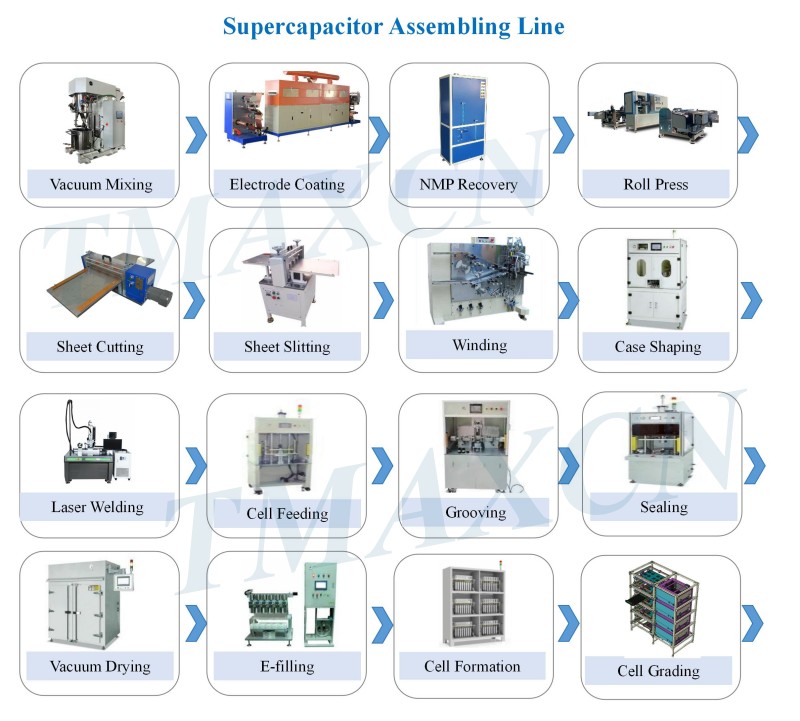Linea di macchine per la produzione di celle cilindriche automatiche
fabbricazione e attrezzatura del laboratorio della batteria agli ioni di litio 18650
diagramma di flusso delle celle a bottone agli ioni di litio ed elenco delle macchine
fabbricazione e attrezzatura del laboratorio della batteria del sacchetto dello Li-ione
- Posta elettronica : David@tmaxcn.com
- Posta elettronica : Davidtmaxcn@gmail.com
- : No. 39, Xinchang Road, Xinyang, Haicang Dist., Xiamen, Fujian, China (Mainland)
A supercapacitor laboratory plant is a specialized facility designed for the research, development, and production of supercapacitors. These energy storage devices are known for their high power density, rapid charge and discharge capabilities, and long cycle life, making them essential for various applications, including electric vehicles, renewable energy systems, and consumer electronics.
● Key Components of a Supercapacitor Laboratory Plant
1. Material Preparation
- Electrode Materials: Supercapacitors typically use activated carbon, graphene, or carbon nanotubes for electrodes. These materials are prepared and processed to enhance their electrochemical properties.
- Electrolytes: Various electrolyte solutions, including aqueous and organic electrolytes, are prepared to optimize the performance of the supercapacitors.
2. Electrode Fabrication
- Coating Equipment: Electrode materials are coated onto conductive substrates (usually aluminum or copper) using techniques like screen printing or spray coating.
- Drying Ovens: Coated electrodes are dried to remove solvents and prepare them for assembly.
3. Cell Assembly
- Stacking/Winding: The prepared electrodes and separators (usually made of porous materials) are stacked or wound together to form cells.
- Electrolyte Filling: The electrolyte is introduced into the assembly, saturating the electrodes and ensuring optimal ionic conductivity.
- Sealing: The cell is sealed in a casing, typically using heat sealing or mechanical methods, to prevent leakage and ensure safety.
4. Formation and Testing
- Formation Cycling: Initial charge and discharge cycles are performed to activate the supercapacitor’s electrochemical properties and stabilize performance.
- Testing Facilities: Advanced testing equipment measures parameters such as capacitance, equivalent series resistance (ESR), energy density, and cycle life to evaluate performance.
5. Quality Control
- Performance Evaluation: Each supercapacitor undergoes rigorous testing to ensure it meets specifications and quality standards.
- Safety Testing: Tests for thermal stability, leakage, and over-voltage conditions are conducted to ensure safety during operation.
6. Research and Development
- Experimental Setup: Dedicated areas for R&D allow scientists and engineers to experiment with new materials, designs, and processes to enhance supercapacitor performance.
- Prototyping: Facilities for rapid prototyping enable quick iterations of design and testing, fostering innovation.
● Advantages of a Supercapacitor Making plant
1. Research Focus: Dedicated facilities enhance the capability to explore new materials and technologies, driving advancements in energy storage.
2. Efficiency: Streamlined processes improve production efficiency, allowing for faster development cycles and increased output.
3. Customization: The ability to tailor supercapacitors for specific applications enhances performance and meets diverse market needs.
4. Integration with Renewable Energy: Supercapacitors can be integrated into renewable energy systems, providing rapid energy storage and discharge, which is crucial for balancing supply and demand.
● Applications of Supercapacitors
- Electric Vehicles (EVs): Used for regenerative braking systems and as supplementary energy sources to enhance performance.
- Consumer Electronics: Employed in devices requiring quick bursts of power, such as cameras and mobile devices.
- Renewable Energy Storage: Utilized in solar and wind energy systems to store and release energy quickly.
- Industrial Applications: Found in applications such as uninterruptible power supplies (UPS) and power quality management systems.
● Conclusion
A supercapacitor laboratory plant plays a crucial role in advancing the field of energy storage through research, development, and production of supercapacitors. As the demand for efficient and sustainable energy solutions continues to grow, these facilities are essential in driving innovation and improving performance in energy storage technologies. With ongoing advancements, supercapacitors are poised to become increasingly integral in various applications, contributing to a more sustainable energy future.
 ru
ru English
English











 +86 13174506016
+86 13174506016 David@tmaxcn.com
David@tmaxcn.com

